Does your cat wee or poo in inappropriate places indoors? Spraying in the home? Avoiding the litter tray? Here we look at the likely causes, and solutions for inappropriate toileting or spraying.
Cats are clean by nature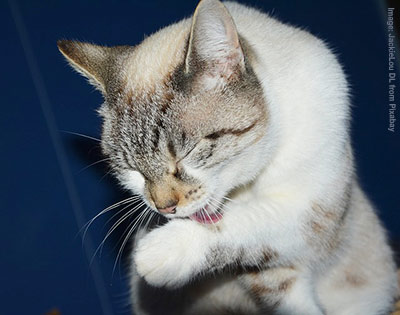
Cats are by nature, very fastidious about their toilet habits and will normally be happy to use a litter tray indoors, or to soil in carefully chosen spots in the garden. If your cat regularly toilets or sprays indoors, it is certainly cause for concern. The occasional one-off accident may happen if a cat is unwell or is suddenly frightened or stressed by a particular event, but if toileting around the home persists, the cause should be investigated, both for the health and welfare of the cat, and also for your own convenience.
Punishment won't work!
The first thing to say, is that punishment is not the answer, and will not work. Scolding, shouting, smacking etc. will only make the cat fearful and stressed, and will most likely make the problem worse. It's worth noting that the cat is not toileting/spraying in undesirable places deliberately to annoy you; something has gone wrong in it's environment or with it's health, and your task now is to discover what it is!
You will first need to establish and eliminate the cause, then you can help the cat to start using the litter tray again. As each cat is unique they might react to problems differently, so the following are general rules which will not always apply to all cats.
Four Main Causes of Inappropriate Toileting in Cats:
Cause 1 - Health Related
Cystitis / Feline Lower Urinary Tract Disease (FLUTD)
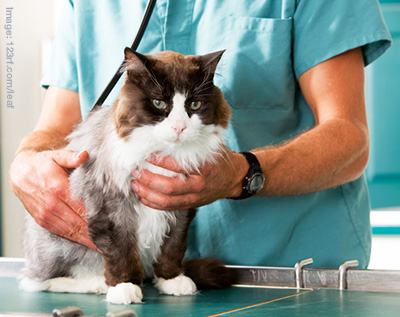 One of the main causes for many litter tray avoidance problems is due to physical conditions such as Feline Lower Urinary Tract Disease (FLUDT) or Cystitis, therefore it is advisable to have the cat checked over by a vet first. Cystitis can cause a cat to urinate in small quantities frequently, and a urinary tract infection can cause irritation and may make the cat favour standing up to urinate, and either condition can cause the cat to urinate outside the litter tray.
One of the main causes for many litter tray avoidance problems is due to physical conditions such as Feline Lower Urinary Tract Disease (FLUDT) or Cystitis, therefore it is advisable to have the cat checked over by a vet first. Cystitis can cause a cat to urinate in small quantities frequently, and a urinary tract infection can cause irritation and may make the cat favour standing up to urinate, and either condition can cause the cat to urinate outside the litter tray.
Cats who suffer repeated bouts of cystitis may benefit from an increased fluid intake or even to change from a dry diet to a wet one, however please consult your vet before changing your cat's diet. For Urinary Infections along with the medication that your vet has suggested the common human remedy of cranberry, orange, and other citrus juices also can help the cats by boosting the acidity of the urine and decreasing the amount of bacteria. A chewable vitamin C tablet a day will reduce the acidity to prevent further infections (always check with your vet first).
Gut Issues
Take particular note of the consistency of your cat's stools, as this can alert you to any gut issues. If your cat is experiencing bouts of loose stools or diarrhoea, they may not be able to get to their usual toileting location in time, and this can result in 'accidents' around the home. Conditions such as Feline inflammatory bowel disease (IBD) or common viral infections such as Feline Coronavirus (FCoV) can cause diarrhoea (Note: FCoV it is NOT related to the human coronavirus Covid-19). So if your cat's stools are looser than normal, take them for a check up at the vet, letting them know what your cat's stools are like (or even take a photo to show them!)
Elderly cats - dementia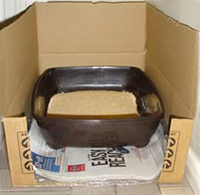 Elderly cats may 'miss' the litter tray sometimes, due to dementia or other age-related conditions. It can help to site the tray inside a suitably sized cardboard box with the top and front cut off (see picture). The three cardboard 'walls' can act as guidance to help them toilet within the tray, and can make them feel safer whilst toileting.
Elderly cats may 'miss' the litter tray sometimes, due to dementia or other age-related conditions. It can help to site the tray inside a suitably sized cardboard box with the top and front cut off (see picture). The three cardboard 'walls' can act as guidance to help them toilet within the tray, and can make them feel safer whilst toileting.
Cause 2 - Litter Tray Related
Solving litter tray and spray problems is possible but it requires a lot of patience, persistence, a systematic plan for retraining and time. Of course these are general rules which not always apply to all cats and in some cases professional help might be required.
New cat - locating the litter tray
If the cat is new to your home and you have allowed him the run of the house straight away, he may be toileting in unacceptable places purely because he has not learned where the acceptable place is! In this case, take him back to basics and confine him to one room (see Bonding Room for more details) with his litter tray, bed, food and water, until the cat has used the litter tray several times (whilst in this room, the litter tray should be sited as far away from his food as possible, and you should interact with your cat often so that he doesn't feel isolated or 'punished'). Once you have decided where to put the litter-trays in the house, keep them there and don’t move them around.
Kittens - litter tray lessons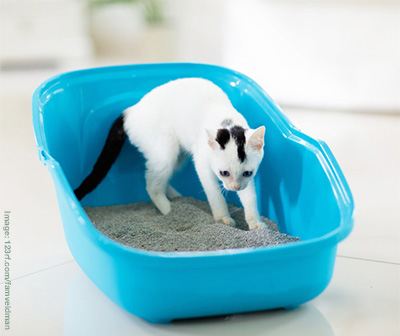 Kittens left to their own devices may decide they prefer other, more convenient locations instead of their litter tray, so you need to limit their ‘exploration areas’ until they learn that the litter tray is the only acceptable place to toilet. A good idea is to confine them to one room (as described in 'New Cat' above), so that they learn to use the tray before extending their territory. It can also be a good idea to start young kittens off with a 'kitten litter' (such as Kitten Attract), until they are ready to move on to using an adult litter.
Kittens left to their own devices may decide they prefer other, more convenient locations instead of their litter tray, so you need to limit their ‘exploration areas’ until they learn that the litter tray is the only acceptable place to toilet. A good idea is to confine them to one room (as described in 'New Cat' above), so that they learn to use the tray before extending their territory. It can also be a good idea to start young kittens off with a 'kitten litter' (such as Kitten Attract), until they are ready to move on to using an adult litter.
Multi-cat households
Inappropriate use of litter tray and spraying are common in multicat homes. Even cats who have previously got along can suddenly start spraying or stop using the litter tray. Cats often don’t like sharing litter trays, so it is better if there is one tray per cat, plus an extra one. Extra litter trays are necessary because some cats like to defecate in one and urinate in another. Others will not use a box that has already been used by another cat. Some cats in a multi-cat household (usually the dominant one) might be overprotective over a particular tray (they see it as theirs and nobody else’s!) and they may try to intimidate or stop others using it by either attacking the other cat when leaving the litter tray, or by bothering them while they are in the litter-tray which can cause the other cat to avoid using it.
Dirty litter or tray
Cats generally prefer to use clean litter. The most common reason for a cats refusing to use a litter tray is because the litter is dirty. Soiled litter should be scooped daily (or more often if required) and the litter tray emptied and filled up with new litter regularly (each type of litter will have instructions as to how often to perform a complete litter change).
Don't be over-anxious about cleaning the tray itself too often though - cats like to smell that it's 'their' tray, and that familiarity can prevent them soiling elsewhere. Scooping the soiled litter will be enough to get rid of nasty smells, but scrubbing the tray itself should on average only need to be done every few weeks (less often if you use a good quality clumping litter, or more often if you use a non-clumping litter). When washing the litter tray, use just hot water and a mild dishwashing liquid. Avoid using chemicals that might leave any kind of smell.
Type of cat litter
The texture of the litter used is also very important. It has to be a litter that the cat likes. Use an un-scented (most cats don’t like perfume and chemical smells), dust-free and flushable litter. Also try to avoid the use of litter tray liners as some cats don’t like them. Sometimes a cat might show a preference for a certain material such as your carpet. If your cat continuously uses a particular material to eliminate on, use this material to retrain the cat to use the box by replacing the litter temporarily with the preferred material and slowly add litter back into the box while reducing the size of the other material over time.
Some cats prefer no litter! Some cats seem to prefer toileting on flat surfaces, and so will avoid trays with any kind of litter in. Such cats will often choose locations such as baths or shower trays to poo in. To find out if this is the case with your cat, only put litter in half the tray (see photo) and leave the other half empty. Place the tray near to one of the areas where they have been choosing to toilet, and you may just find that they use the non-litter half of the tray. Maybe not what you intended, but it's better they poo in the tray than on the floor!
Some cats seem to prefer toileting on flat surfaces, and so will avoid trays with any kind of litter in. Such cats will often choose locations such as baths or shower trays to poo in. To find out if this is the case with your cat, only put litter in half the tray (see photo) and leave the other half empty. Place the tray near to one of the areas where they have been choosing to toilet, and you may just find that they use the non-litter half of the tray. Maybe not what you intended, but it's better they poo in the tray than on the floor!
Types of litter tray
Make sure that the litter tray is the right size for the cat. A tray that is too large or too small can put the cat off using it.
Some cats don't like covered litter trays as they do not offer an easy escape route, and they can also trap the smells inside, which some cats dislike. If your cat is avoiding a covered tray, simply removing the flap / door may encourage him to use it again.
For high spraying cats, you can purchasing a “high sided” litter box. These are available online, or from most good pet supply stores. Alternatively, you can use a large plastic storage box, and cut out a side panel for access: See 'DIY Litter Box' Video.
Soiling outside the litter tray?
If a cat is toileting outside the litter tray, it can help to re-train them by switching temporarily to a 'kitten litter' (such as Kitten Attract), which is often preferred by cats who are not keen on regular litter. Using a kitten litter for a while can get him into the habit of using his tray again, and then slowly re-introduce an adult litter (perhaps by mixing the two to begin with), and eventually it should be possible to switch back to using only an adult litter. If the cat is elderly, they may miss the litter tray sometimes, due to dementia or other age-related conditions. Siting the tray inside a cardboard box with the top and front cut off (see picture in section 1 here) can help guide them to toilet within the tray.
Litter tray location
Review the location of the litter tray(s). Litter trays kept in different areas can prevent location-avoidance problems. They should be sited in places where it is safe for the cat (with at least an exit so they don’t feel vulnerable and exposed to danger with no escape) as well as being easy to get to. Site litter trays in quiet, private places that are easily accessible by the cat, and where it will not be disturbed by children or ambushed by other pets. Avoid noisy areas near washing machines, and busy thoroughfares.
A house with more than one floor should have a litter tray on each level. Litter trays should never be placed near food and water bowls, as cats do not like to toilet near their food. If your cat continues to toilet inappropriately in a particular spot away from the litter tray, try moving the litter tray to that spot, and then slowly over several days, move it back to where you want it.
The use of remedial products may also be considered (see under Remedial Products below).
Cause 3 - Outdoors Related
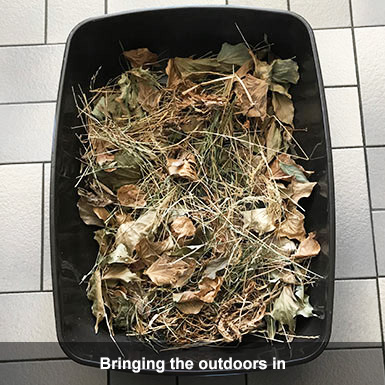 Sometimes a cat who normally toilets outside may decide they don't want to go out, and so ends up toileting indoors, in unwanted places. A cat may be reluctant to go out if they are feeling slightly unwell, or if there is a perceived threat such as from another cat (see 'Feeling threatened by other cats / dogs' below) , or even because it is raining or cold! It can be tricky to persuade a cat to use commercial litter if they are used to going outdoors, so one solution is to bring the outdoors in. Natural material from your garden, such as dry grass clippings or dried fallen leaves can be used instead.
Sometimes a cat who normally toilets outside may decide they don't want to go out, and so ends up toileting indoors, in unwanted places. A cat may be reluctant to go out if they are feeling slightly unwell, or if there is a perceived threat such as from another cat (see 'Feeling threatened by other cats / dogs' below) , or even because it is raining or cold! It can be tricky to persuade a cat to use commercial litter if they are used to going outdoors, so one solution is to bring the outdoors in. Natural material from your garden, such as dry grass clippings or dried fallen leaves can be used instead.
Using dried natural material is also eco-friendly, as it will biodegrade easily when discarded. You could either bury the soiled material in your garden (where it would have ended up if your cat had toileted outside!), or since a scoop won't work too well with grass and leaves, just wrap it in a sheet of newspaper and pop into your household rubbish.
NB: It is always best to gather grass clippings from your own garden, rather than from public spaces, so that you can be sure it is free from any chemicals (fertilizer / weedkiller etc). Also, carefully check for bugs and insects as you collect the material, so that you don’t accidentally bring them indoors too.
Cause 4 - Anxiety or Stress Related
If a health issue or problems with the litter tray can be ruled out, then you need to consider that the problem could be anxiety-related.
Spraying - when & where?
Is the cat is spraying in one area or several? If the cat has chosen one spot, he may be submissively trying to mark a little territory. Does the spraying occur after an encounter with another cat? It could be hidden aggression.
A change in the cat's environment?
Has there been a change in the household? Any intrusion on the cat's territory, whether human, animal, or even a new piece of furniture or decoration can cause a cat to feel threatened, insecure or stressed. The more cats in the household, the more likely that one or more of them might develop toilet and spraying problems.
Clean the soiled areas thoroughly (see cleaning advice below) and if possible confine the cat to a smaller area until he starts using the litter tray again. The confinement room should be warm and comfortable and equipped with litter-trays, fresh food and water (food and water should be located away from the litter trays) and a bed and toys. You should also make sure you visit and interact with the cat regularly so that he doesn't feel 'punished'. This should take no more than a few days, maybe less, and then he can be re-introduced to the rest of the house.
Feeling threatened by other cats / dogs  Cats are at their most vulnerable when they are toileting outside and therefore they may feel threatened by another cat, or dog, or even by any loud noises in the environment such as road works. They may then choose to toilet indoors, even if no litter tray has been provided. Providing a discreetly placed litter tray indoors should take away the feelings of anxiety and encourage him to use this more suitable place.
Cats are at their most vulnerable when they are toileting outside and therefore they may feel threatened by another cat, or dog, or even by any loud noises in the environment such as road works. They may then choose to toilet indoors, even if no litter tray has been provided. Providing a discreetly placed litter tray indoors should take away the feelings of anxiety and encourage him to use this more suitable place.
If you wish to then encourage your cat to toilet outside again, one good idea is to designate a specific place in your garden for this purpose. Choose an area of soil quite close to the house (so that he can retreat to the house quickly if he feels under threat) in a quiet corner of the garden. Rake the soil over and and mix in a good proportion of sand or paper-based or wood-based litter.
Reassure your cat
Help your cat feel comfortable in his home territory. Play games with him and talk to him frequently in a low and reassuring voice. Give him positive attention and affection and reward him when he uses the litter tray. A confident, secure, and relaxed cat does not need to relieve anxiety and stress by such extreme measures as urine or faecal marking and spraying.
The use of remedial products may also be considered (see under Remedial Products below).
Deterrants
Taken on their own, attempts to put the cat off from soiling in a particular place using deterrants such as tin foil, lemon peel etc. may simply result in the cat finding another inconvenient site, and will delay finding out the cause of the behaviour, and therefore are only of value in conjunction with determining the cause. The idea though, is to make the inappropriate toileting spots undesirable and unavailable for your cat.
If you are dealing with a spot or two, you may try to put a bowl of food over the area. Cats don’t want to eliminate where they eat. If it is possible try putting a litter box over the area and then slowly move it to a more discreet place (gradually).
Aluminium foil can be a deterrent, as it makes a sound when sprayed which some cats don’t like (although please note that this doesn’t work for some cats as they seem to like chewing it which can be dangerous). Others advise using plastic to cover the spots but again some cats seem to find it rather ‘tasty’ so you need to be aware of your cat’s preferences. Double sided tape seems to work in many cases too.
Remedial Products and Specialist Help
Remedial Products
Using Feliway Classic spray on the areas daily, and/or having a diffuser in the room(s) can reduce or even eliminate the problem. The calming pheromones create a comforting environment, helping to alleviate stress symptoms such as spraying or inappropriate toileting. Find out more here: www.feliway.co.uk. There is also a calming spray called 'Pet Remedy' which may help, and is available from most vets.
Cleaning urine stains & eliminating smells
 The most effective way to clean urine stains and/or remove the smell of spraying, is to use a good quality enzymatic urine cleaning solution (such as 'Simple Solution') - this will break down the uric acids and salts in the urine. Products are available for both soft surfaces (carpets / upholstery etc) and for hard surfaces (floors / cupboards etc).
The most effective way to clean urine stains and/or remove the smell of spraying, is to use a good quality enzymatic urine cleaning solution (such as 'Simple Solution') - this will break down the uric acids and salts in the urine. Products are available for both soft surfaces (carpets / upholstery etc) and for hard surfaces (floors / cupboards etc).
Most home-made cleaning remedies do not dissolve the enzymes, which then release smells for years, encouraging your pet to continue spraying in that area. A cat can smell an old urine stain, even if you cannot!
Don't use cleaning products containing ammonia, as your cat is quite likely to urinate there again to cover the smell up, thus continuing the cycle. Avoid using bleach too, as it can cause damage or discolouration to many surfaces.
Locating the urine or spray areas
If spraying is extensive, a urine detector torch (UV 'Blacklight'), will enable you to find the exact locations.
Specialist help
In some cases the problem is more complex than that outlined above, in which case we would advise that you discuss the situation with your veterinary surgeon initially. Occasionally, extreme behavioural problems can be treated with medication but drugs are always best used together with behaviour therapy, and not as a sole solution. Your vet will be able to refer you to a specialist in feline behaviour in your area (also see Pet Behaviour links).
Further Information and Links
Behavioural help - Association of Pet Behaviour Counsellors: www.apbc.org.uk
Behavioural help - Canine & Feline Behaviour Association: www.cfba.co.uk
Feliway Classic can prevent spraying, find out more here: www.feliway.co.uk
International Cat Care: Soiling Indoors
International Cat Care: Spraying / Marking
Grateful thanks to K. Zurbanu BSc (Hons) (Psych) BSY(PetPsy) and also to International Cat Care for advice and information when compiling this page.



